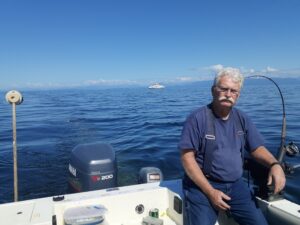It’s a great facility – one of the first off-the-shelf – and there was no end of support from everyone.” – Bruce Evans, Director, Fanny Bay Harbour Authority
Bruce Evans describes his childhood self as a “water rat”. From four years of age, he spent his summers at his parents’ cabin on Island Lake, north of Edmonton. It was, undoubtedly, a formative start instilling his “draw to marine life.”

By 20, Bruce made the move. He hitchhiked his way out to the west coast looking at where he’d formally pursue his passion for marine biology.
Finding his way
“When I arrived in Victoria and saw people sitting out on the grass, while back home we were knee deep in snow, I knew this was the place for me,” says Bruce, who ended up completing his marine biology degree at the University of Victoria.
His career path after leaving school never ventured far from the water. From his first job at the Bamfield Marine Station studying marine algae, he later studied geoducks, worked for the Department of Fisheries and Oceans, followed by years of shellfish production (both oysters and scallops). Bruce eventually landed at the Fanny Bay Harbour Authority in 2001. He remained there as director for two decades, leaving a legacy of projects that have helped expand the Fanny Bay Harbour’s production capabilities and attract the attention of harbour authorities from across the country.
Big wins
When reflecting on some of his proudest career moments, Bruce doesn’t hesitate.
“The Fanny Bay Harbour loading ramps was definitely a highlight,” says Bruce, of the nearly $2 million infrastructure project he oversaw starting in 2011.
This initiative, which many small businesses in the industry later compared to winning the lottery, helped improve off-loading efficiency resulting in impressive productivity gains for local shellfish producers.
“It was a fairly unique process in how we packaged the project with so many partners, including ICET, and at a time when the seafood industry was rapidly expanding.”
Challenges
There were admittedly “some challenges to pull all the people from different agencies together in the same calendar year with different reporting requirements” (not to mention escalating production costs that gave Bruce a “real head shake”). But, in February 2012, Bruce was contacted while on vacation in Mexico. He had received the news he’d been hoping for: extra funds were made available, and the concept would not only become a reality, but a success.
“It’s a great facility – one of the first off-the-shelf – and there was no end of support from everyone,” says Bruce of the initial vision. “It provides improved access to the ocean, and more efficient and safe offloading capacity for small and large businesses.”
Expanding shellfish industry
The second most notable career highlight for Bruce was the achievement of a personal dream: another invaluable large infrastructure project that would further expand the shellfish industry in the region.
“The infrastructure development projects at the Fanny Bay Harbour provided the opportunity for three FLUPSIES (Floating Upweller Systems) to operate. They support shellfish growth in our area by producing and ensuring access to an economical source of seed,” says Bruce of the $1.25 million project that also involved building floating breakwaters and tie-up space for shellfish protection.
Staying close to the water
It was shortly after this project, that Bruce retired. Not unexpectedly, for someone of his fervour, he hasn’t strayed far from the organization or the water.
“(The Harbour Authority) was a great experience to be a part of and I still sit on the Board to help provide the history and connection with the other Harbour Authorities,” he says. “The people I’ve worked with over the past 30 years have all been motivated, driven, type-A personalities. For me, I think my own strengths have simply been my experience, as much as anything.”
If that is true – that experience is Bruce’s strength – then he continues to get stronger by the day.
Bruce’s enduring enthusiasm for marine life has continued to flow into his retirement. Annual fishing trips around the coast include areas like Barkley Sound, Nootka Sound, the Salish Sea as well as Johnstone Strait. “My comfort zone is the water.”
Remaining optimistic
And while the aquaculture industry has gone through some challenging times over the past few years, Bruce remains hopeful.
“We’re making such huge progress in the area of genomic research – whether that be evidenced through the pandemic or in genetic understanding of diseases in the wild salmon,” he says. “These areas of research are providing direction for us all – on how we can move forward, in how we lived historically and how we can continue living today.”
###
Bruce is currently working on a portable shellfish hatchery, in hopes to provide shellfish seed to remote communities on the coast.
Share your story
We’re honoured to present stories from inspiring people who are creating positive impacts in communities across the coast. If you have a story idea you think we should share, please reach out to us!